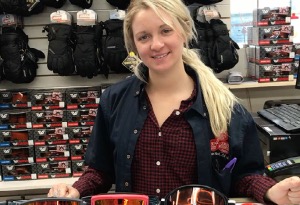Winter Sports Tips
Skiing and snowboarding are great sports that can be enjoyed in any weather provided you are prepared. Hopefully we can help make your experience on the mountain the most enjoyable. You are coming to the mountain to enjoy it. Being prepared can be the difference between having a good day and sitting inside.
What you need:
There are several things that we as “locals” have in our quiver of goods. These are items that we use on a regular basis and are on our list of things that everyone must have.

Goggles
Everyone must own a set of goggles and not the cheapest thing you can find. Goggles not only protect your eyes from the obvious elements such as wind and snow but they allow you to see better. Goggles will highlight the terrain in bad or “flat” light conditions.
- Ok, you may think it looks cool to be in sunglasses on a snowy day. The fact is that you can’t see as well, your upper body tenses up and the avid skier wonders if you checked your common sense at the bottom of the lift.
- Goggles must have a double lens. A double lens goggle greatly reduces fogging. A double lens is two lenses that make up the goggle lens. To tell of your goggles have double lenses simply squeeze the goggle lense with your thumb and first finger. You will feel both lenses move.
- Better goggles work better. Plan on spending around $40 and up for goggles. A very high end set of goggles will cost $150. Not everyone needs these. The $40 price range is a goggle that has good features and lenses. The better the goggle the better it will resist fogging and see in flat light conditions.
- Any goggle can fog. A few things that will help you. Don’t put your goggles on your hat. This will fog them immediately. Keep the top vents of the goggles free of snow or any other obstruction. Watch your breathing. If you are breathing and the warm air goes into your goggle it could fog. Breath away from the goggle. If they should fog pull the bottom of the goggle away from your face to increase air flow.
- Cleaning your goggle. Anything can scratch a goggle, even the nice soft chamois and bags they come in. When cleaning your goggle use light pressure and never a paper product. If in doubt, clean an area out of your field of vision just in case. If you should get snow in your goggles do not wipe it out as the snow crystals will scratch the lens. Tap it out and then allow the snow to melt when you go in for a break.
- Keep your goggles in the bag they came in. Also watch what you put them next to in your bag.
- Don’t lay the lens down when not in use. Enough said.
Hat or Helmet
- You can loose 20% or more of your body heat out of your head.
- Helmets, we wear them in case someone hits us! Many people think that they are not an expert and don’t need a helmet. You are more likely to fall as a novice or less experienced skier/snowboarder than the expert. Expert by the definition of the word is a more skilled user.
- Hats, on cold or semi cold days they just keep us warmer. The warmer we are the more likely that we are looser and more agile.
Neck Gaiter
- This is an item that keeps your neck warm. On cold days you can pull it up over your face and nose. Other than goggles this may be the best $10 you will spend. You are warmer, more relaxed and will be able to enjoy the mountain better on any day it is cold or snowing. No, your high collar on your jacket does not do the same thing.
Ski Socks
- Ski socks are designed to give you a better fit in your ski/snowboard boot and keep you warmer. You sock must come up out of the boot. It must hold it’s shape at all times and contain no or flat seems. Ribbed socks will sooner or later cause pain. It must not be made of cotton, unless of course you want your feet to freeze. Recommended materials are wool or a synthetic insulated material. Many people think they are alergic to wool when they have only used cheap wool that is abrasive and scratchy. Check out the higher quality wools and socks. They are soft and rarely cause any problems.


